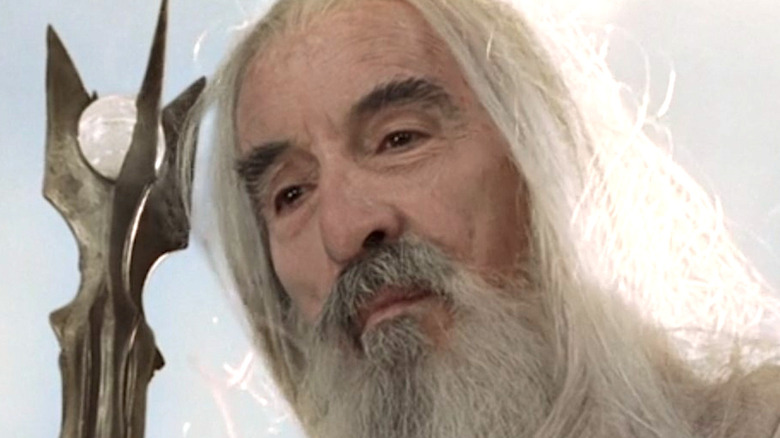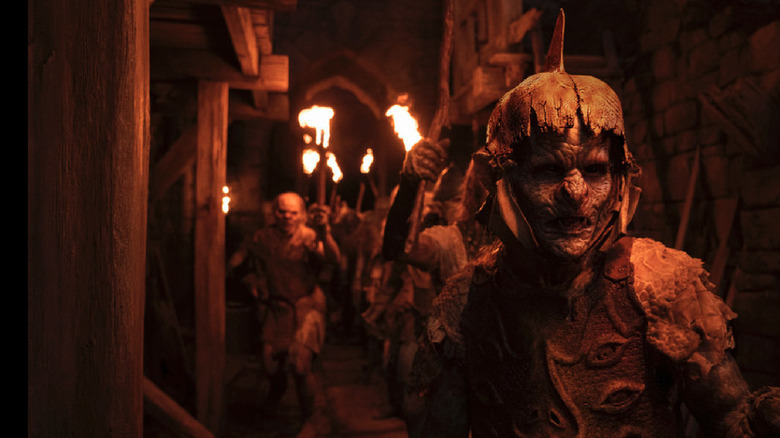Amazon's The Rings Of Power Reveals Its Take On Lord Of The Rings' Most Abundant Monster
Amazon Studio's enormously expensive, highly-anticipated "The Lord of the Rings: The Rings of Power" series is quickly approaching its September 2 premiere date. The streaming giant has been slowly releasing little tidbits of information about different aspects of the show in the lead-up to that date, like the gripping first trailer released during the 2022 Super Bowl. So far, that breadcrumb trail has included a solid dose of intel. We've learned a lot about the proto-Hobbit Harfoots that the creators have developed for the show. We've also heard about things like the importance of language for the story, why the show has a massive budget, and how the narrative will be condensed to a much shorter timeline than Tolkien's nearly 3,500-year original chronology.
While we've seen plenty of updates about the Amazon adaptation's protagonists, though, we haven't seen much in the way of its antagonists. Sure, there is a glimpse of an ice troll from the first trailer. And, of course, the old man in the fire from that footage could be read as imposing. But there have been pitifully few details about who our heroes will be facing — until now.
On June 21, an exclusive report from IGN has given us our first real look at a creature that sprang from the mind of J.R.R. Tolkien and found a home on the page in the 20th century. The report draws information from an interview with Jamie Wilson, the head of the prosthetic department on "The Rings of Power," as well as executive producer Lindsey Weber — both of whom dish out plenty of grizzly details.
The Rings of Power will give Orcs their due
Traditionally, Orcs are seen as little more than cannon fodder in Tolkien's works. Yes, they occasionally are given dialogue and personalities, but by and large, they're pretty one-dimensional. They are malicious, terrified of their own masters, and they come in bulk. At least, that's how J.R.R. Tolkien's Orcs have been depicted in the past. However, according to crew members Jamie Wilson and Lindsay Weber, "The Lord of the Rings: The Rings of Power" is determined to shine a more comprehensive light on this vile yet fascinating Middle-earth culture.
Weber told IGN that she loves Orcs and creature design. She added that showrunners Patrick McKay and J.D. Payne have an equally strong love for them. "They love practical prosthetics and design," the executive producer shared, "and they felt that they needed exploration given that this is the Second Age and thousands of years before the events of the Third Age."
The premise for Orcs at this point in the Middle-earth timeline is that they were all but wiped out just before the era when the show is set. The Orcs are also pictured as scattered and scavenging rather than organized into the dominating force that Sauron later uses.
Wilson pointed out, "Everyone thought, 'Yay, they've been wiped off Middle-earth.' But really they regressed into the dark in small little groups, and hid away, and lived in tunnels and sort of under Middle-earth." In "The Rings of Power," these antagonists re-emerge under a "so-called new leader who's going to lead them forward" — a possibly veiled reference to Joseph Mawle's character, who is been rumored to play a corrupted Elf named Adar and serve as the first season's primary antagonist (via Twitter).
The Rings of Power team is invested in giving Orcs dimension
Lindsey Weber's final statement near the end of the IGN interview reveals how much the "Rings of Power" team wants to breathe life into the Orcs in their iteration of Middle-earth. "My hope is that people will find dimension in [the Orcs] that they didn't previously consider and that they will be thrilled and horrified and also maybe feel a little something along the way."
This jives with Jamie Wilson's opinions on how Orcs will be represented in the show. The head of prosthetics adds that the appearance of the Orcs in "The Lord of the Rings: The Rings of Power" is different from those thousands of years later during "The Lord of the Rings." Wilson shared, "The way I described it to my team, it's a bit like these are the baby versions. They're not actually babies, but it's them coming out from the darkness."
Wilson goes on to explain that his Orcs aren't as battle-damaged or muscular. Their skin is also lighter at this point and it doesn't feature the same degree of wrinkles and skin damage — even though there is still some of that going on thanks to the sun's powerful rays. Overall, this description gives the feeling of an Orc that is still in its, let's say, youth? It seems the show's team really wants to paint a serialized picture of how we eventually got to the battle-hardened group that fights in the War of the Ring, two long eras in the future.
The Orcs will also grow their numbers
In one of the more dramatic moments for Tolkien fandom, Lindsey Weber teased that there will also be female Orcs taking center stage as the race attempts to re-populate. This is sure to send ripples through the diehard Tolkien community, not because of the focus on females so much as the debate that swirls around where Orcs originated from in the first place.
It appears "Rings of Power" will depict actual Orcish communities with males and females that are trying to repopulate their diminished numbers and re-establish their dark, cruel culture. This generally lines up with what J.R.R. Tolkien wrote to a certain degree. As with many aspects of his world, the author went back and forth about where Orcs actually came from. This led to several different versions of their origin story over the decades that he was writing. Depending on the version you're looking at, Orcs can be soulless animals, corrupted Elves, and even, in later writings, warped or corrupted Men.
The early version of the legendarium found in "The Book of Lost Tales Part Two," talks about Orcs being bred by Sauron's master, Morgoth, "of the subterranean heats and slime." In "The Silmarillion," it states that, while their origin is technically unknown, the wise believe Orcs come from captured Elves who "by slow arts of cruelty were corrupted and enslaved" adding that Morgoth bred "the hideous race of the Orcs in envy and mockery of the Elves, of whom they were afterwards the bitterest foes." That text also clarifies that they multiply in the same manner as Elves and Men.
While interesting, the debate surrounding Orcish origins is anything but definitive, and it appears that "The Rings of Power" has picked their preferred version and run with it.
Orc practical effects are a big deal
One of the biggest criticisms of Peter Jackson's "The Hobbit" trilogy is the extreme use of CGI. Computer-generated graphics are rampant throughout, unlike his earlier "Lord of the Rings" trilogy which leaned heavily on real-life prosthetics and practical effects. "The Lord of the Rings: The Rings of Power" seems set on returning to that earlier, more life-like format, and this includes how they present the Orcs.
In the interview, Jamie Wilson explains that, while CGI is certainly a factor for "The Rings of Power," prosthetics remain a central focus. "So, therefore, we tried to use real prosthetics and everything and minimize the visual effects, because there are hundreds of productions that are heavy on visual effects, and you can see it, that the human eye is getting better and better and knows what is real and knows what isn't because we are just getting so deloused with all this product that you begin to know."
Wilson even breaks down how the decades before "The Rings of Power" have improved these very literal visuals and make-up elements. He explains that the foam latex of the past has been fully replaced by encapsulated silicon, adding, "So, all the ears, noses, Orcs pieces are all made in encapsulated silicon, which is basically two layers of silicon with a moveable piece of silicon in the middle, so when it's applied to the actor's face, they can move and it works."
From prosthetics to procreation, comprehensiveness to culture, "The Rings of Power" is trying to bring a new version of Tolkien's minions to life. It will be interesting to watch them trace a more detailed picture of this classically evil race and see what depth and dimension this adds to one of Middle-earth's oldest groups of antagonists.




